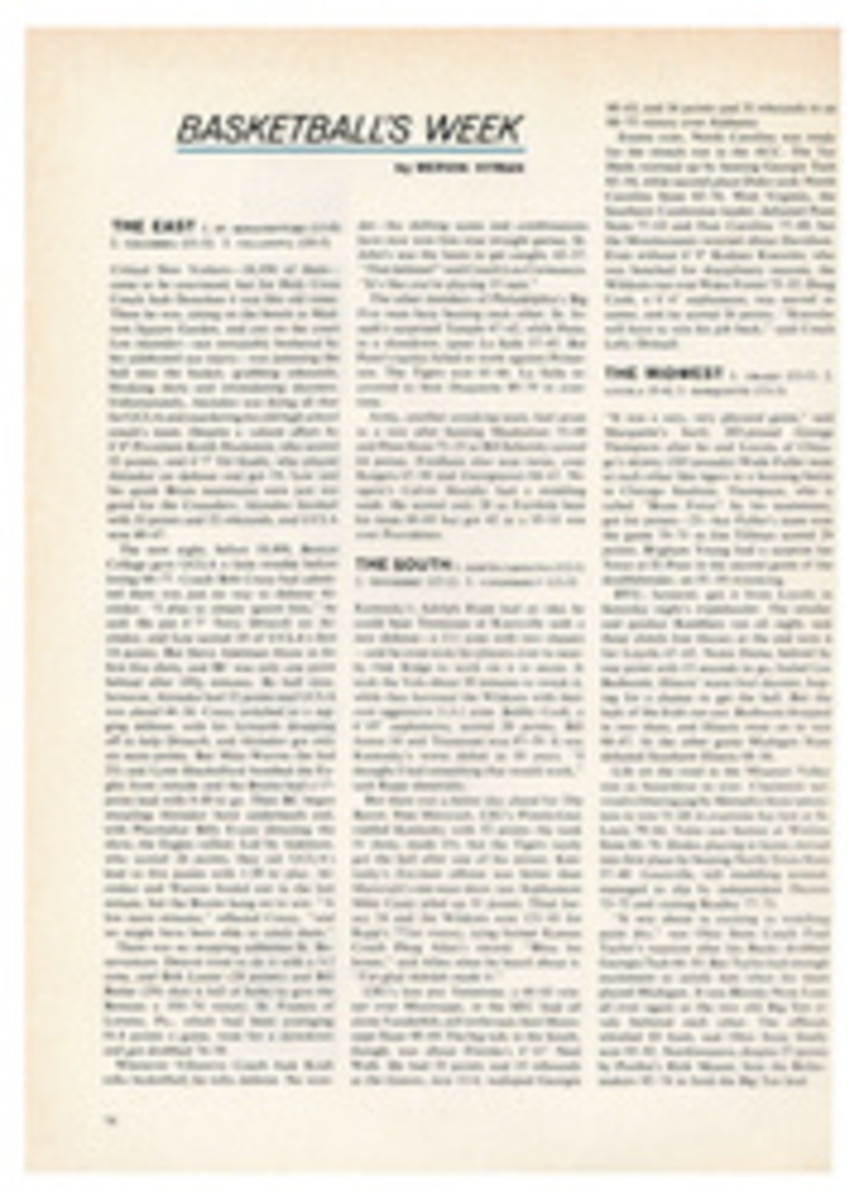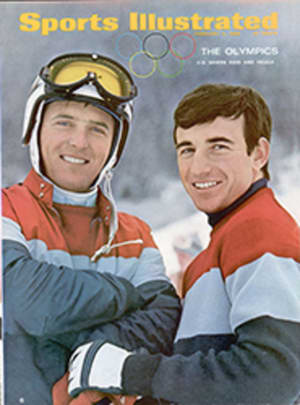
TRACK HAS A HIGH OLD WEEKEND
Bob Seagren stood on the pole-vault runway, flashing his handsome smile at the cameras and saying nice things to the people who congratulated him. He had just set a world indoor record of 17'4¼", and his voice could hardly be heard over the cheers of the 14,088 spectators in Madison Square Garden. "These people seem so near to you here," he said, "but I like it. In fact, I'd rather vault indoors than out. I think the noise, the tension and the whole atmosphere make indoor track more fun."
Last weekend 44,546 people in five cities enjoyed the unique atmosphere of indoor track. Seagren's performance at New York's Millrose Games highlighted the season's busiest track period, but the track enthusiasts in Oakland, Boston, Portland and Albuquerque also got plenty of action. There were few important records set, but competition was good and, as usual, indoor track was a colorful, bizarre spectacle.
In Boston, a relay start was delayed while carpenters were summoned to repair a cracked plank on the rickety old board track. In New York, Dave Patrick lost a bitterly fought mile to Preston Davis, went to the dressing room and changed into street clothes—and then was barred by special cops from returning to the crowded floor to watch the rest of the meet. In Albuquerque, the 60-yard hurdles were held up until late in the evening because the star. Earl McCullouch, was delayed on his flight from Oakland. The Pearl, undefeated this season, rushed in just in time—and then caught a spike on a hurdle and wound up flat on his face. In Oakland, Tom Laris was beaten up by four kids while training outdoors for the three-mile race, and in the race itself Van Nelson was hit and knocked offstride by a falling vaulting pole. Nelson dropped from first place back to fifth but recovered to salvage second, and went home with one of the most unusual alibis in the history of losers.
Among the few normal occurrences of the strange weekend was the double victory of Seagren in New York on Thursday and in Boston on Saturday. Thursday in the Millrose Games he made his 11th 17-foot indoor vault, giving him an 11-0 edge over the rest of the world. Saturday night in Portland the gap was narrowed when Altti Alarotu, a Brigham Young University freshman from Finland, became the second man to clear 17 feet indoors. But, in Boston, Seagren casually brought his own total to a dozen.
Seagren operates with almost mechanical precision. He shocked a few people by carelessly missing his first try at 16 feet in the Millrose Games, but then quietly and undramatically took care of things. He made 16' and 16'8" with plenty to spare, while the last of his rivals were being eliminated. The bar was raised to 17' and the crowd tensed. New Yorkers had never seen a 17-foot vault, and Seagren had obligingly promised them one. He did all the mysterious measuring and studying that pole vaulters do, and then walked back to the end of the runway. Hardly pausing for effect, he took off, his face twisted into a grimace, and shot upward. He made it with almost disdainful ease.
With the bar raised to an indoor-world-record 17'4¼" he missed twice, but on his third and last try he cleared the bar and dropped on his back into the pit with his arms raised in triumph.
"Damn, another world record!" yelled Vern Wolfe, Seagren's coach at Southern California. "Hey, Bob, what are you going to do for an encore?"
"The rafters, coach, the rafters."
Seagren ordered the bar raised to 17'8", a quarter of an inch above the pending outdoor record held by his teammate, Paul Wilson. He also switched poles, a fairly bold experiment to make in the middle of a meet after setting a record. "I just can't get my hands high enough on a 16-foot pole to feel comfortable at 17'8" or higher," he said, reaching into a cardboard cylinder to produce a 17-foot black and white weapon called a Cata-Pole. "It would be incredible if he made 17'8" with that big pole," said veteran vaulter Mel Hein. "Every pole is different. You always need time to get used to one."
Hein was right. Seagren did not come very close at 17'8" and in fact went back to the 16-foot pole for his final try. "I'll put the new pole away until I have a chance to work with it," he said. "As we go higher, we're going to have to use it."
"You mean you expect to go higher soon?" he was asked.
"When you look up at the bar 17'8" doesn't look any different from 17'4". There's no barrier. There's no limit."
Seagren celebrated until 4:30 Friday morning in New York, slept most of Friday and Saturday, and arrived at Boston Garden on Saturday night in a disgruntled mood. "First, I read in one of the papers that I've promised them a 17-footer tonight. I never said that. I don't want everybody to think that I'm a cocky kid who's going to go around to every meet telling people what he can do." Seagren was even more annoyed by the cab drivers of Boston, who persistently refused to take him and his poles to the Garden. "I've fit them in many cars," he said after he finally reached the arena, "but they wouldn't even let me show them how. So I was delayed getting here and naturally I'm in a bad mood. I don't usually perform very well when I feel this way."
He did well enough, clearing 17'¼" on his first try at that height with the same kind of efficiency he had shown in New York. All his opponents failed to clear 16 feet, so once again he ended the evening as an isolated figure. While relay teams scurry about and middle-distance men battle for position with elbows flying, Seagren is off by himself, working at his specialized, technical craft. Some track nuts find fascination in the cool, scientific aspect of it all, but many people tend to watch Seagren with distant admiration, then turn eagerly back to some school relays, where kids still compete with other kids.
"That's the wrong attitude," said Steve Schoonover. "Vaulting involves thinking and emotion as much as technical equipment and skill. You can always add four inches just on guts." Schoonover, who goes to Harvard, was unplaced behind Seagren in Boston. His best vault ever is 15'8", unimpressive by today's standards but nonetheless as high as Cornelius Warmerdam ever went. In June he will graduate, after completing a full premed course in three years; in October, when Seagren goes to the Olympics, Schoonover will be at Harvard Medical School. This is too bad in a way, because Schoonover would be nice to have around whenever Seagren vaults. Seagren does it best, but Schoonover probably explains it best. He may be track's greatest contribution to philosophy—and his philosophy is just crazy enough to fit the indoor track scene.
"Seagren will do 18 feet before the end of the summer," he predicted. "And I will do 17—eventually."
"Why?" he was asked. "Because poles are getting better, or training methods have improved?"
"No, it's not that. Let me explain," he said. "You've heard of the Maharishi Mahesh Yogi? You know how he's helped the Beatles and so many others accomplish things? Well, he's got the secret of pole vaulting—transcendental meditation. He convinces people that they can do anything if they really think about it and tell themselves they can. He's had guys pick up scalding hot stoves in India with their bare hands and not feel a thing. If they can do that, we can sure improve by four inches at a time by meditation."
Seagren, no deep thinker, did explain his big weekend in terms of his mental attitude. "Your frame of mind can be the difference between a record and a mediocre night. In the two meets before the Millrose Games I just couldn't get off the ground. I was practicing the same, and doing the same things. But I felt flat. Then the Millrose Games, with the big crowd and the excitement, gave me a big mental lift. That's what indoor track can do for you."
PHOTO
Seagren, grinning broadly, accepts congratulations after his record pole vault in New York.

